 I’ve never met Itakagaki Paru (obviously) – the writer and artist behind Beastars. But I imagine she must be an incredibly fascinating person. She has an interesting story to begin with, being the daughter of a legendary mangaka (Grappler Baki’s Itagaki Keisuke) and downplaying their relationship until her own series became a hit. But boy, based on this series I’m guessing she must have a lot of issues. The whole series has the feel of an exercise in psychotherapy, the work of a dazzlingly smart person with more questions about life than answers.
I’ve never met Itakagaki Paru (obviously) – the writer and artist behind Beastars. But I imagine she must be an incredibly fascinating person. She has an interesting story to begin with, being the daughter of a legendary mangaka (Grappler Baki’s Itagaki Keisuke) and downplaying their relationship until her own series became a hit. But boy, based on this series I’m guessing she must have a lot of issues. The whole series has the feel of an exercise in psychotherapy, the work of a dazzlingly smart person with more questions about life than answers.
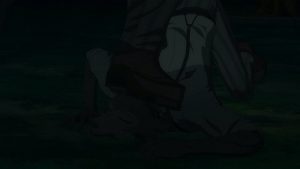 In Legosi Itagaki has created the perfect centerpiece for her explorations, he of his “innocent mind and devilish body”. He too is someone with a lot more questions about life than answers – a smart kid who dreams of things that never were, and asks “why not?” On a visceral level he understands the elemental divide between carnivores and herbivores, because his devilish body feels its eternal tug. But on an intellectual and emotional level he yearns for a world that transcends it. Not just so he can be with the herbivore he loves, but so he can be with guys like Tem and call them friends, with no barriers between them.
In Legosi Itagaki has created the perfect centerpiece for her explorations, he of his “innocent mind and devilish body”. He too is someone with a lot more questions about life than answers – a smart kid who dreams of things that never were, and asks “why not?” On a visceral level he understands the elemental divide between carnivores and herbivores, because his devilish body feels its eternal tug. But on an intellectual and emotional level he yearns for a world that transcends it. Not just so he can be with the herbivore he loves, but so he can be with guys like Tem and call them friends, with no barriers between them.
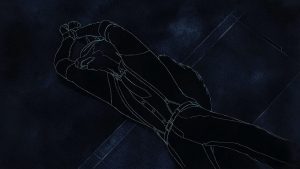 I can only once more praise Orange and director Matsumi Shinichi for the entire sequence beginning when Legosi is attacked and beaten by a fearsomely strong opponent he never lays eyes on. We know how strong Legosi is, so whoever and whatever this was must be a true beast indeed. Is it Tem’s killer, as Legosi assumes? I’m not so sure, but the way this is drawn – and paired with Kousaki Satoru’s seemingly incongruous piano score – is beautiful and terrible. All Legosi can do is get a taste of his opponent to remember him by, and when Jack somehow puts two and two together and arrives to help, Legosi is in a terrible state.
I can only once more praise Orange and director Matsumi Shinichi for the entire sequence beginning when Legosi is attacked and beaten by a fearsomely strong opponent he never lays eyes on. We know how strong Legosi is, so whoever and whatever this was must be a true beast indeed. Is it Tem’s killer, as Legosi assumes? I’m not so sure, but the way this is drawn – and paired with Kousaki Satoru’s seemingly incongruous piano score – is beautiful and terrible. All Legosi can do is get a taste of his opponent to remember him by, and when Jack somehow puts two and two together and arrives to help, Legosi is in a terrible state.
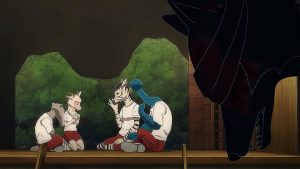 Poor Jack, loyal hound he is, realizes that metaphorically if not literally (and maybe both) Legosi is leaving him behind. It seems as if the world simply isn’t going to allow Legosi to have an innocent mind any longer, and it seemed he was doing a lot more than physically jumping a fence. The world beyond Cherryton’s walls is brutal and terrible, and Legosi can only think of one person he can turn to for help –
Poor Jack, loyal hound he is, realizes that metaphorically if not literally (and maybe both) Legosi is leaving him behind. It seems as if the world simply isn’t going to allow Legosi to have an innocent mind any longer, and it seemed he was doing a lot more than physically jumping a fence. The world beyond Cherryton’s walls is brutal and terrible, and Legosi can only think of one person he can turn to for help – Ling Ling Gouhin, the alpha male panda guard at the dark market. But Gouhin, wary of the Shishigumi, is dubious to say the least, and refuses Legosi’s plea to train him to fight. Legosi, however, isn’t giving this one up without a fight.
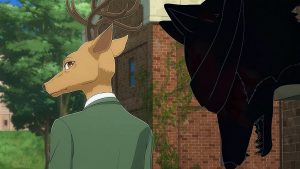 Meanwhile, we meet Cosmo (Hara Yuko, who also plays Shiira), a stripper at “Happy & Heaven Jingle Theatre”. She’s some sort of exotic antelope (okapi?), who takes it all off for a crowd of drooling carnivores every night. She’s the headline act, earning her the envy of her fellow dancers. Cosmo is a spitfire, disdainful of the beasts she enflames from behind bars on stage, seeing her power over the desires as a sort of leveller for the power they hold over her life. The symbolism practically drips from the walls in this scene, lending new meaning to the term “sexual predators”.
Meanwhile, we meet Cosmo (Hara Yuko, who also plays Shiira), a stripper at “Happy & Heaven Jingle Theatre”. She’s some sort of exotic antelope (okapi?), who takes it all off for a crowd of drooling carnivores every night. She’s the headline act, earning her the envy of her fellow dancers. Cosmo is a spitfire, disdainful of the beasts she enflames from behind bars on stage, seeing her power over the desires as a sort of leveller for the power they hold over her life. The symbolism practically drips from the walls in this scene, lending new meaning to the term “sexual predators”.
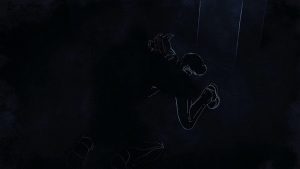 Louis’ arrival with the Shishigumi comes in the nick of time to save Cosmo from the end she says she’s always been expecting, foisted upon her by a jealous colleague. Under Louis’ lead the Shishigumi is well on their way to stamping themselves as the Robin Hood of the dark market, and drumming up tons of new business in the process. To Cosmo Louis represents everything she despises – but that’s before she realizes he’s in charge of a pack of lions. I can’t imagine Cosmo being introduced for any reason apart from being a potential love interest for Louis, but we’ll have to stay tuned on that score.
Louis’ arrival with the Shishigumi comes in the nick of time to save Cosmo from the end she says she’s always been expecting, foisted upon her by a jealous colleague. Under Louis’ lead the Shishigumi is well on their way to stamping themselves as the Robin Hood of the dark market, and drumming up tons of new business in the process. To Cosmo Louis represents everything she despises – but that’s before she realizes he’s in charge of a pack of lions. I can’t imagine Cosmo being introduced for any reason apart from being a potential love interest for Louis, but we’ll have to stay tuned on that score.
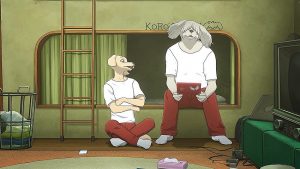 Louis seems to represent the antithesis of Legosi, someone who’s embraced the darkness in the world and seeks to suck every ounce of power and gratification he can out of it before it kills him. He still goes through the motions of eating meat every night, only to vomit it back up as his body wastes away. Louis’ pride refuses to allow him to be seen eating vegetables in front of his troops, and it’s only the intervention of Ibuki (who’s embarrassed to be seen buying it) that Louis gets a salad at last. “When in Rome” is one thing, but Louis is certainly living a lie. In a sense he’s achieved the bridge between carnivores and herbivores that Legosi strives to build, but one built on sand and seemingly destined to one day collapse…
Louis seems to represent the antithesis of Legosi, someone who’s embraced the darkness in the world and seeks to suck every ounce of power and gratification he can out of it before it kills him. He still goes through the motions of eating meat every night, only to vomit it back up as his body wastes away. Louis’ pride refuses to allow him to be seen eating vegetables in front of his troops, and it’s only the intervention of Ibuki (who’s embarrassed to be seen buying it) that Louis gets a salad at last. “When in Rome” is one thing, but Louis is certainly living a lie. In a sense he’s achieved the bridge between carnivores and herbivores that Legosi strives to build, but one built on sand and seemingly destined to one day collapse…


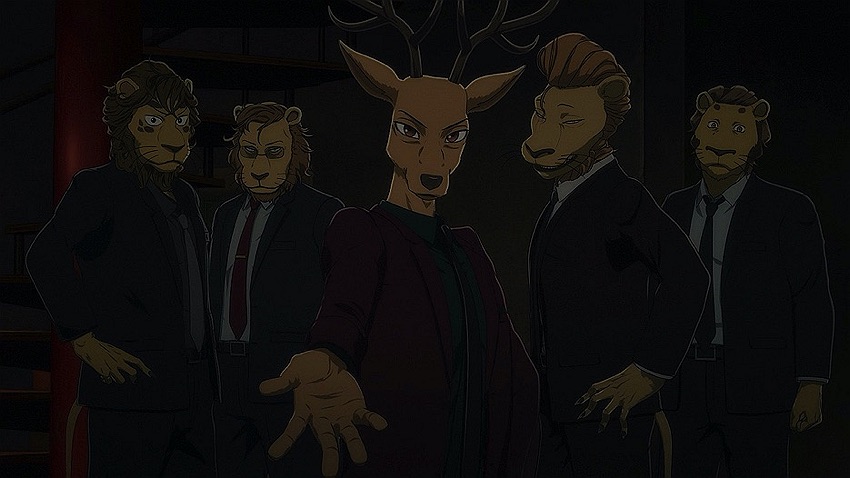
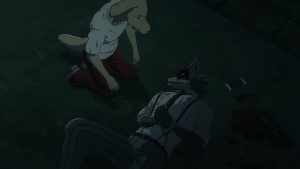
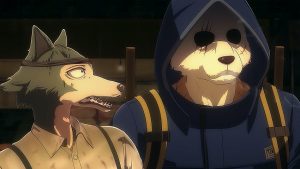
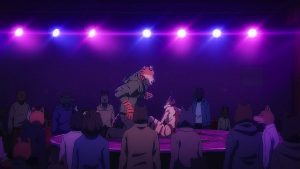
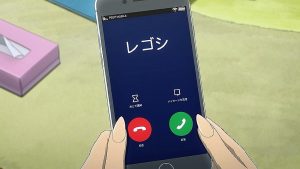
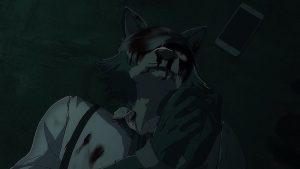
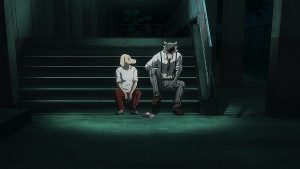
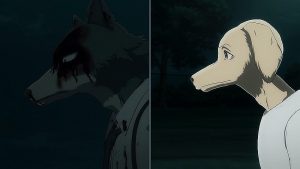

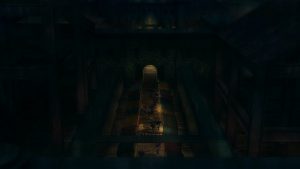
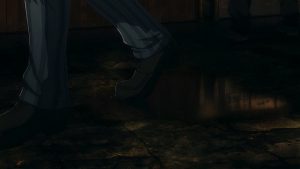
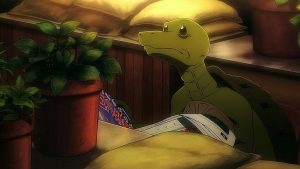
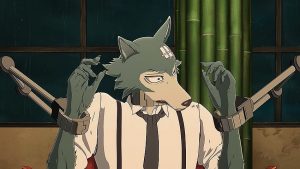
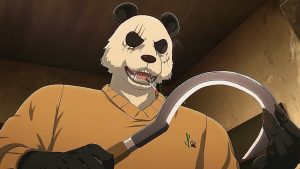

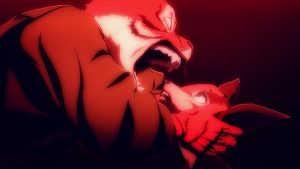
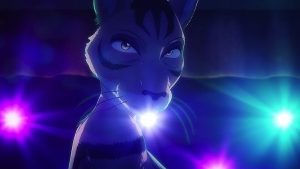

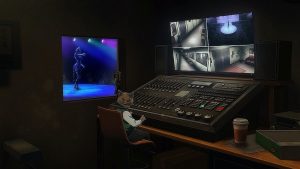
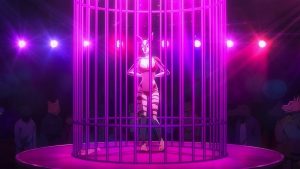
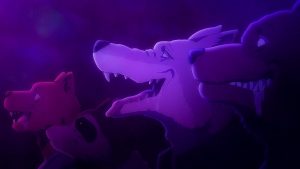
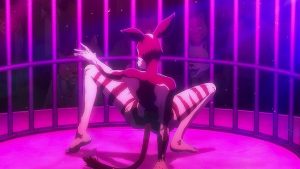
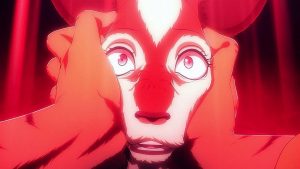
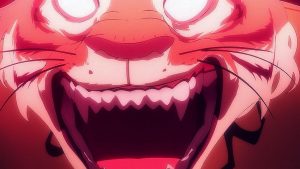
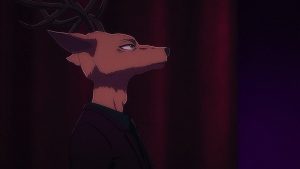
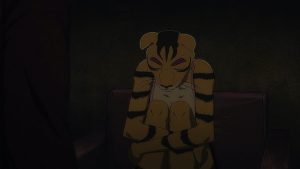

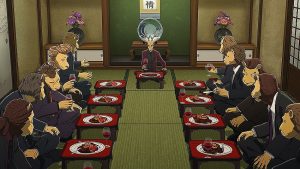
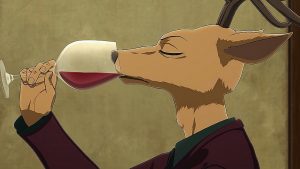
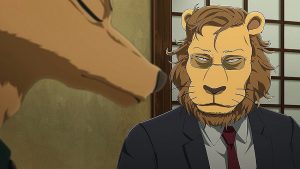


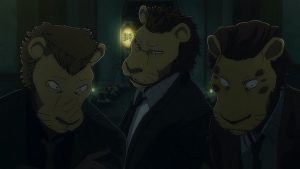
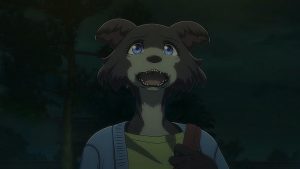

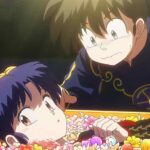
Ronbb
February 1, 2021 at 6:13 amA fascinating review for a fascinating episode of a fascinating series…thanks, Enzo.
Another reflection is that the voice acting is good. It could be harder to relate to the show when all characters are animals. However, the sound, music, voice acting, writing and direction are all good and in sync that animals or not makes no difference at all.
Guardian Enzo
February 1, 2021 at 7:43 amKobayashi Chikahiro I think has especially had an amazing run, between Legosi, Sugimoto, and Rikuo from Yesterday. Great range and authenticity.
Ronbb
February 2, 2021 at 12:28 pmAgreed!
Color2413
February 1, 2021 at 6:15 pmThe character animation is remarkable, particularly because it is CGI. I don’t know how they did it (motion capture?), but I can’t recall any 2D hand-drawn animation that surpasses it. Lugosi’s facial expressions and body language beautifully underscore his conflicts and uncertainties.
Guardian Enzo
February 1, 2021 at 6:29 pmWithout any question the best character animation in any CGI series I’ve seen. But the direction generally is great on top of that.
Ronbb
February 2, 2021 at 12:30 pmPressed the button too fast…lol…that’s meant for Enzo’s reply to my comment…